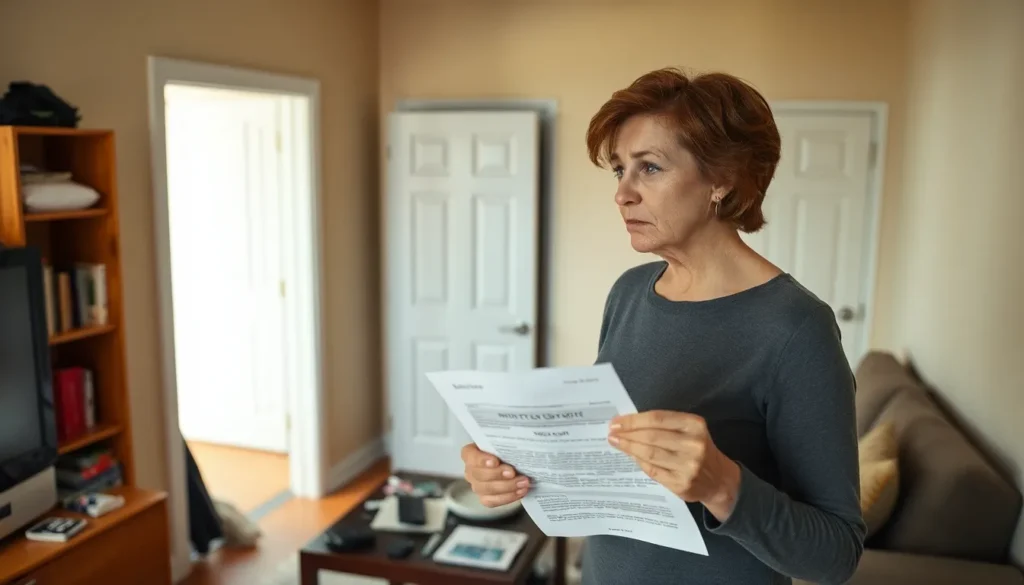Table of Contents
ToggleIn the world of renting, few things are as dreaded as the “notice to quit.” It’s like receiving a breakup text when you thought everything was going well. But fear not! Understanding this legal document can save tenants from unexpected surprises and landlords from potential headaches.
What Is a Notice to Quit?
A notice to quit serves as a formal notification from a landlord to a tenant, indicating the intent to terminate a rental agreement. This document typically outlines the reason for termination, such as non-payment of rent or lease violations. Landlords use it to communicate their expectations clearly, providing tenants with an opportunity to remedy any issues.
Various jurisdictions dictate specific requirements for a notice to quit. Some areas require the notice to be in writing, while others allow verbal communication. Notice periods can range from a few days to several weeks, depending on local laws and the nature of the lease violation.
Tenants often receive a notice to quit when they fail to meet their rental obligations. For example, a tenant who misses multiple rent payments might find themselves facing a notice. Understanding the terms of the lease agreement is crucial, as specific clauses may stipulate the conditions under which a notice can be issued.
Responses from tenants can vary. Some may choose to address the issues highlighted in the notice, while others may seek legal assistance to contest the validity of the notice. Effective communication between tenants and landlords often helps resolve disputes before escalation.
Landlords benefit from issuing a notice to quit as it prompts timely action regarding rental compliance. A clear notice can prevent misunderstandings and facilitate smoother transitions when ending a tenancy. Both parties should remain informed and proactive in addressing any issues related to the rental arrangement.
Types of Notices to Quit
Notices to quit come in various forms, each addressing specific situations related to rental agreements. Understanding the different types helps both tenants and landlords navigate their rights and responsibilities effectively.
Immediate Notice to Quit
Immediate notices to quit require tenants to vacate the property right away. These notices often result from severe lease violations, such as illegal activities or significant damage to the rental unit. Landlords use this type of notice when immediate action is necessary to protect the property or the surrounding community. Typically, the tenant does not get a grace period, as the nature of the violation demands urgency. Some jurisdictions may allow for a restitution claim if the tenant fails to comply with the immediate notice.
Non-Payment Notice to Quit
Non-payment notices to quit focus on cases where tenants fail to pay rent on time. Landlords issue this notice when rent remains unpaid after a specified period, which may vary by location. Often, the notice includes instructions for settling the balance and a timeline for paying before eviction proceedings begin. In some areas, tenants may have a window—often 3 to 30 days—to resolve the payment issue before further action is taken. Understanding this type of notice is crucial for tenants to avoid eviction and maintain compliance with their rental agreements.
Legal Requirements for a Notice to Quit
A notice to quit must adhere to specific legalities. Understanding these requirements ensures all parties are protected and informed.
State-Specific Regulations
State regulations determine notice to quit procedures. Each jurisdiction sets distinct rules regarding the content, format, and required notice periods. For instances, some states mandate that notices be in writing, while others permit verbal communication. A common example includes California, where a three-day notice applies for non-payment of rent. In contrast, New York offers a fourteen-day notice for lease violations. Tenants and landlords must familiarize themselves with local laws to avoid potential disputes.
Proper Delivery Methods
Delivery methods affect the efficacy of a notice to quit. Many jurisdictions specify acceptable ways to serve the notice, such as certified mail, personal delivery, or posting on the rental property. For example, delivering a notice via certified mail provides proof of receipt. Personal service may also ensure immediate acknowledgment by the tenant. Posting the notice on the front door serves as a last resort where direct communication fails. Choosing the proper delivery method enhances the likelihood of compliance and reduces misunderstandings.
Consequences of a Notice to Quit
Receiving a notice to quit can lead to several significant consequences for tenants. A tenant typically faces the possibility of eviction if they fail to comply within the notice period specified. Landlords may initiate legal proceedings to regain possession of the property when compliance doesn’t occur.
Renters often experience stress caused by uncertainty regarding their living situation. Moving can incur costs, whether financial or logistical, posing a challenge for tenants needing to find alternate housing quickly. Legal repercussions may also arise, especially if tenants contest the notice without sufficient grounds or fail to respond appropriately.
Understanding regional laws is crucial, as they dictate specific timelines and requirements for responses. Some jurisdictions require a tenant to act within three days, while others allow up to fourteen days for compliance. Missing these deadlines can expedite eviction processes.
Additionally, tenants may risk damaging their credit scores if eviction proceedings occur. Negative marks can hinder future rental applications, as landlords often check credit history. A legal battle may also ensue if the tenant disputes the notice, leading to court costs and extended stress.
Landlords, conversely, may face ramifications from issuing a notice. If a notice fails to meet legal standards, it may become invalid, delaying the eviction process and prolonging troublesome situations. Clear communication can often mitigate misunderstandings, benefiting both parties involved. Prompt and informed responses to notices can help tenants retain their housing.
Common Issues and Disputes
Receiving a notice to quit often leads to confusion and anxiety among tenants. Tenants may dispute the notice if they believe it lacks legal basis, arguing that proper procedures weren’t followed. Landlords could face challenges regarding the clarity of the notice itself, which might lead to miscommunication or incorrect assumptions.
In many cases, tenants might question the validity of reasons listed in the notice. Documentation supporting the claims, such as rent records or lease agreements, enhances credibility. When disagreements arise over outstanding rent, tenants may provide receipts or bank statements as proof of payment.
Additionally, challenges occur when landlords fail to provide enough notice as required by law. Many jurisdictions mandate specific timelines, and noncompliance can disrupt the eviction process. This discrepancy can lead to disputes about whether tenants should vacate immediately or have additional time to remedy the situation.
Both parties may experience issues with delivery methods outlined in legal requirements. For example, if a notice is sent via email when personal delivery was mandated, the notice may not be considered valid. Misunderstandings during this aspect can create unnecessary legal battles.
Legal representation often becomes a factor when disputes escalate. Tenants may seek legal counsel to navigate their options, particularly if an eviction seems imminent. Landlords should also seek guidance to ensure notices comply with local laws and regulations.
Ultimately, effective communication remains crucial in resolving these disputes. Clear dialogue between tenants and landlords prevents misunderstandings. By addressing concerns promptly, both parties can work towards amicable solutions, minimizing stress related to the notice to quit.
Conclusion
Understanding a notice to quit is essential for both tenants and landlords. It serves as a crucial tool in maintaining rental agreements and addressing potential issues before they escalate. By recognizing the specific requirements and procedures associated with these notices, both parties can navigate the complexities of rental relationships more effectively.
Open communication is key in resolving disputes and fostering a cooperative environment. When tenants respond promptly and landlords adhere to legal standards, they can minimize stress and avoid unnecessary complications. Ultimately, being informed and proactive can lead to more harmonious rental experiences.







